Exploring Shuanglin Temple: The Marvels of Chinese Architecture
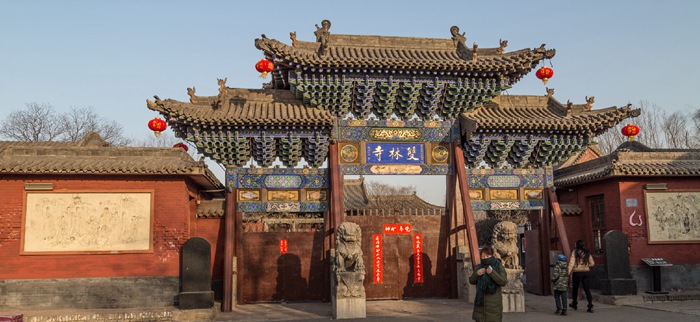
An Essential Guide to Visiting Shuanglin Temple
In This Guide
- An Essential Guide to Visiting Shuanglin Temple
- The Rich History and Legends of Shuanglin Temple
- Main Highlights: What You Absolutely Can’t Miss
- Planning Your Visit: A Practical Guide
- Tickets: Prices, Booking, and Tips
- How to Get There: A Complete Transportation Guide
- Local Cuisine and Accommodation Nearby
- Frequently Asked Questions
- Final Thoughts on Your Trip
Nestled just a stone’s throw from the historic town of Pingyao, Shuanglin Temple (双林寺) stands as a captivating testament to China’s rich cultural and architectural heritage. Founded during the 6th century and later renovated in the 12th century, this temple complex enchants visitors with its stunning collection of nearly 2,000 intricate terracotta sculptures and clay figures, many of which date back to the Ming and Qing dynasties.
As you step through the temple’s wooden gates, you are transported into a world where history and spirituality intertwine. The air is infused with the whispers of ancient rituals and the echoes of devoted prayers, inviting you to explore the temple’s many halls dedicated to various Buddhist deities. Each structure reveals unique themes, from the serene figure of the Bodhisattva to the imposing Arhats, offering a glimpse into the profound beliefs that have shaped this remarkable site.

Shuanglin Temple.
Visitors often comment on the temple’s somewhat dusty condition, a reflection of the passage of time and perhaps a hint of the preservation challenges faced by such historic locations. Yet, it is precisely this rawness that adds to Shuanglin’s charm, allowing you to experience its authentic atmosphere away from the throngs of more polished tourist destinations.
Whether you are a history buff, a culture enthusiast, or a spiritual seeker, Shuanglin Temple promises an enriching experience that connects you to the very essence of China’s Buddhist legacy. Prepare to be awe-inspired as you wander through its sacred halls and contemplate the artistry that has stood the test of time.
The Rich History and Legends of Shuanglin Temple
A Journey Through Time: The History and Legends of Shuanglin Temple
Nestled in the serene landscape of Pingyao County, Shuanglin Temple (双林寺) is not just a sanctuary for the spirit; it is a treasure trove of history and artistry that dates back over 1,400 years. Founded in the 6th century during the Northern Qi Dynasty, this temple has witnessed the ebb and flow of Chinese history, making it an essential stop for travelers interested in the rich tapestry of Chinese culture.
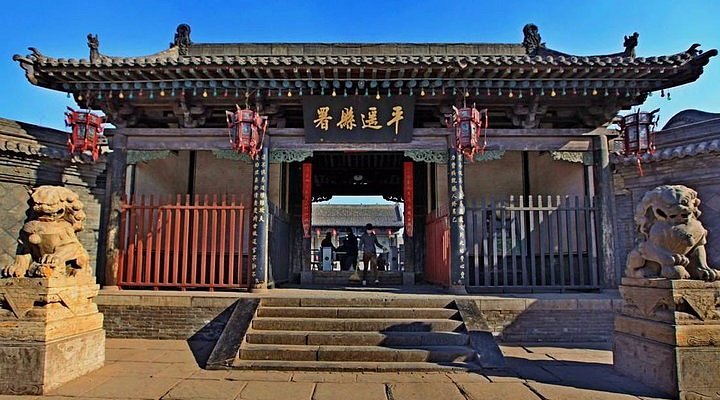
Shuanglin Temple.
Architectural Marvel
Shuanglin Temple is renowned for its unique architectural style, which combines elements from various dynasties, particularly the Tang (618-907) and Song (960-1279) periods. The temple complex comprises numerous halls and pavilions, each adorned with intricate wooden carvings, colorful murals, and nearly 2,000 terracotta sculptures. These sculptures, created between the 12th and 19th centuries, are considered among the finest in China and depict a variety of Buddhist figures, including Bodhisattvas, Arhats, and protective Devas.
Visitors often find themselves enchanted by the thematic halls dedicated to different aspects of Buddhism and folklore. The Thousand Buddhas Hall, for instance, showcases an array of Buddha statues, each telling a story — a reflection of the temple’s deep spiritual significance.
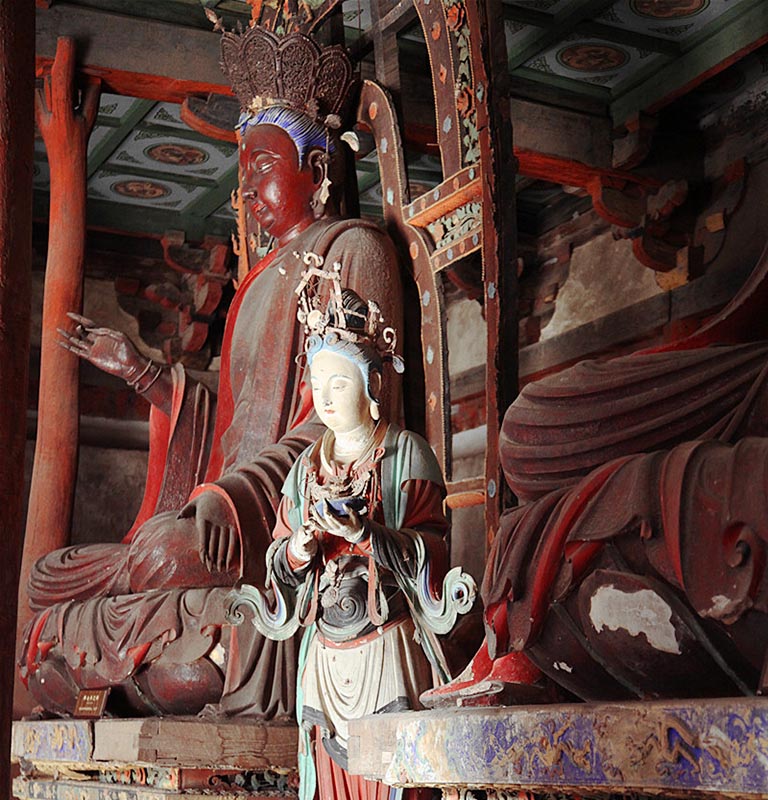
Shuanglin Temple.
Legends and Lore
Beyond its architectural beauty, Shuanglin Temple is steeped in legends that add a mystical layer to its history. One prominent tale speaks of a guardian spirit said to protect the temple and its treasures. Locals believe that this spirit manifests in the form of a white tiger, which has been spotted roaming the grounds during significant festivals. This legend speaks to the temple’s enduring role as a spiritual sanctuary.
Another popular story involves a Buddhist monk who, during a period of drought, prayed fervently for rain. His devotion supposedly led to a torrential downpour that saved the crops of nearby villages. In gratitude, the villagers contributed to the temple’s maintenance and expansion, allowing it to flourish as a center of worship and community.
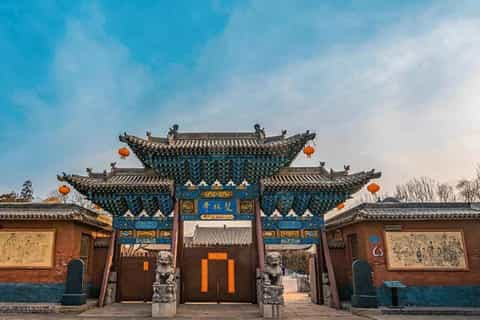
Shuanglin Temple.
Cultural Significance
Shuanglin Temple is not merely a relic of the past; it continues to be a vibrant site for religious and cultural activities. It serves as a backdrop for various Buddhist ceremonies, festivals, and art exhibitions, making it an integral part of the local community. The temple’s preservation efforts are ongoing, with hopes that its rich history will remain protected for future generations.
Conclusion
For international travelers seeking a deeper understanding of Chinese history and culture, Shuanglin Temple offers a unique glimpse into the spiritual and artistic heritage of the region. Its stunning sculptures, rich legends, and serene ambiance make it a must-visit destination that invites exploration and reflection. As you wander through its hallowed halls, you’ll not only witness the artistry of ancient craftsmen but also feel the pulse of a living history that continues to inspire awe.
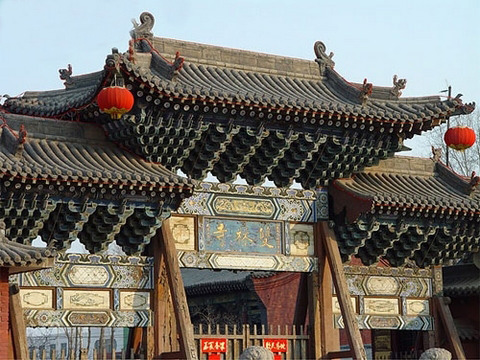
Shuanglin Temple.
Main Highlights: What You Absolutely Can’t Miss
Discover the Unmissable Highlights of Shuanglin Temple
Nestled just a short drive from the ancient town of Pingyao, Shuanglin Temple (双林寺) is a treasure trove of Chinese Buddhist art and history, making it a must-visit for travelers seeking to delve deeper into China’s rich cultural tapestry. Founded in the 6th century, this remarkable temple complex is renowned for its stunning collection of sculptures, historical architecture, and serene atmosphere. Here are the main highlights you absolutely can’t miss during your visit.
1. The Terracotta Army of Sculptures
Shuanglin Temple boasts nearly 2,000 exquisite terracotta statues, ranging from the 12th to 19th centuries. Each piece serves as a testament to the artistic prowess of ancient Chinese craftsmen. Among these, you’ll find representations of arhat (enlightened beings), bodhisattvas, and deities, all intricately detailed and filled with rich symbolism. Don’t miss the Thousand Buddhas Hall, where countless Buddha images line the walls, creating a breathtaking visual experience.
2. Architectural Marvels
The architecture of Shuanglin Temple is as captivating as its artwork. The temple complex features various halls, each with unique themes and intricate wood carvings that resemble delicate lacework. The craftsmanship of the wooden structures, combined with the tranquil setting, creates an ambiance that feels both sacred and timeless. Be sure to explore the main hall where the statues are displayed, although photography is restricted inside to preserve the sanctity of the space.
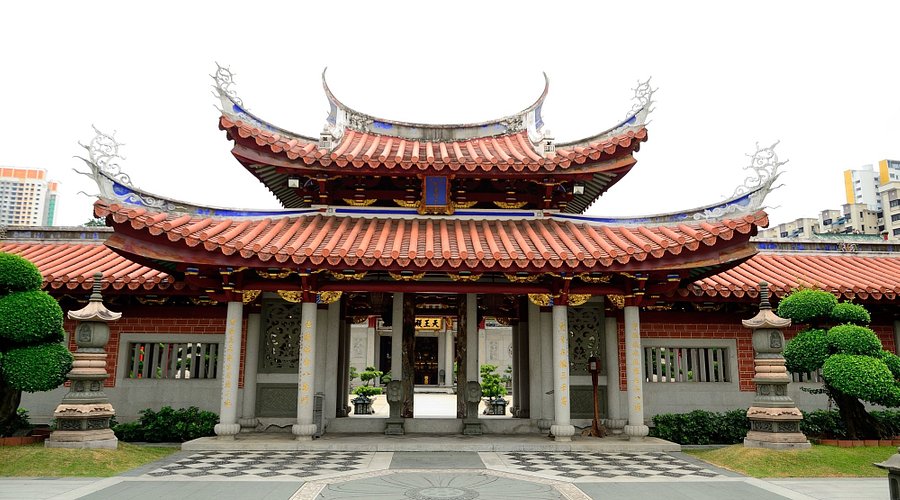
Shuanglin Temple.
3. A Journey Through Different Halls
As you wander through the temple, you’ll encounter different halls dedicated to various Buddhist figures and teachings. Each hall offers a distinct atmosphere and artistic style. The Hall of Devas and the Hall of Arhats are particularly noteworthy, with their elaborate carvings and serene depictions of spiritual figures providing insight into Buddhist beliefs and practices.
4. Historical Significance
Shuanglin Temple is not just an artistic marvel; it is also steeped in history. It has served as a spiritual center for centuries, witnessing the evolution of Buddhist practices in China. A knowledgeable guide can enhance your experience by sharing stories and historical context that bring the temple’s significance to life.
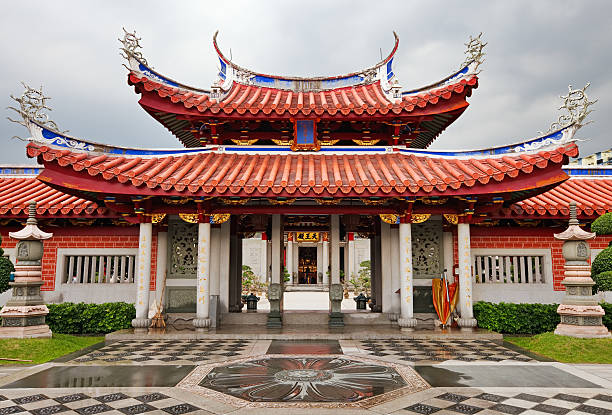
Shuanglin Temple.
5. Off the Beaten Path
Unlike some of the more crowded tourist spots, Shuanglin Temple offers a peaceful retreat where you can enjoy the art and architecture without the throngs of visitors. The tranquil environment allows for reflection and appreciation of the craftsmanship and spirituality that permeate the grounds.
6. Proximity to Pingyao
Located just 7 kilometers from Pingyao, Shuanglin Temple is easily accessible and fits perfectly into a day of exploration. Consider pairing your visit with a tour of the Ancient City of Pingyao or the Wang Family Compound to experience a full day of cultural immersion.
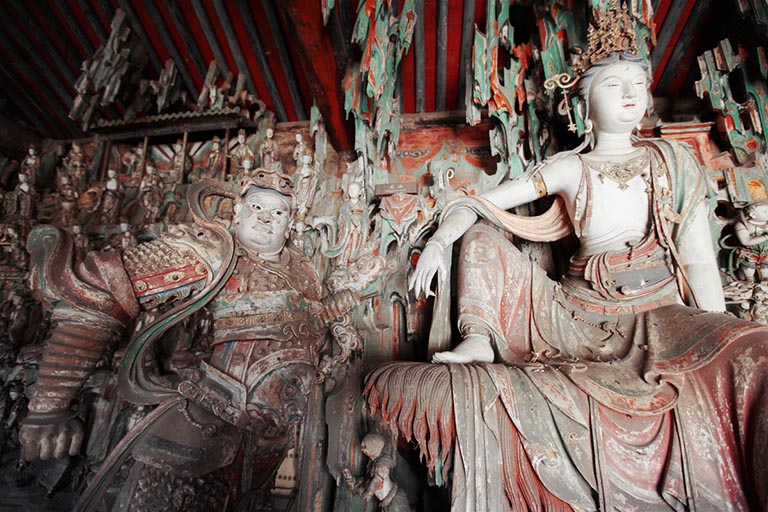
Shuanglin Temple.
Conclusion
A visit to Shuanglin Temple is a journey into the heart of Chinese Buddhist art and history. From the stunning array of sculptures to the intricate architecture, every aspect of this temple invites exploration and contemplation. Whether you’re an art enthusiast, a history buff, or a spiritual seeker, Shuanglin Temple promises an enriching experience that you won’t soon forget. Don’t miss this hidden gem on your travels through China!
Planning Your Visit: A Practical Guide
Your Essential Guide to Visiting Shuanglin Temple
Nestled just a short drive from the ancient city of Pingyao, Shuanglin Temple offers a captivating journey into China’s rich history and artistic heritage. With its impressive collection of sculptures and serene atmosphere, a visit to this remarkable site is a must for anyone interested in Chinese culture. Below are vital tips and information to enhance your experience at Shuanglin Temple.
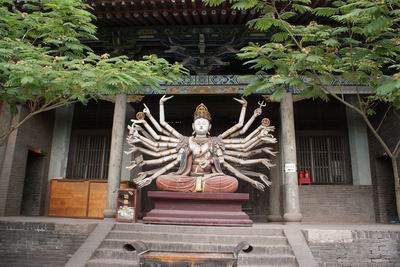
Shuanglin Temple.
Getting There
- Location: Shuanglin Temple is situated in Qiaotou Village, Zhongdu County, approximately 7 kilometers from the heart of Pingyao.
- Transportation Options:
- Taxi: A convenient and direct option, taxis are readily available in Pingyao. Expect a short 10-20 minute ride.
- Private Tours: Consider booking a private tour that includes Shuanglin Temple along with other nearby attractions, such as the Wang Family Compound or the Zhangbi Castle.
Admission and Opening Hours
- Admission Fee: Typically, there is a small entrance fee; check for the latest pricing as it can vary.
- Hours of Operation: The temple usually opens daily from 8:00 AM to 5:00 PM. It’s advisable to arrive early to avoid crowds and enjoy a tranquil visit.

Shuanglin Temple.
What to Expect
- Architectural Highlights: Shuanglin Temple is notable for its stunning architecture and nearly 2,000 clay and terracotta sculptures, some dating back to the 12th century. The sculptures depict various Buddhist figures, including Bodhisattvas, Arhats, and Devas, making the temple a treasure trove for art enthusiasts.
- Thematic Halls: Each hall within the temple features different themes and artistic styles. Having a knowledgeable guide can significantly enhance your understanding of the intricate religious meanings behind the artworks.
Tips for Your Visit
- Photography: Be aware that photography is restricted inside certain areas of the temple, particularly where the most impressive sculptures are located. Always check for signs and respect any regulations regarding photography.
- Dress Code: As a place of worship, it is recommended to dress modestly. Comfortable shoes are advisable as you will likely be walking on uneven surfaces.
- Guided Tours: Engaging a local guide can provide invaluable insights into the temple’s history, architecture, and the significance of its artworks. Consider booking a private tour to enrich your experience.
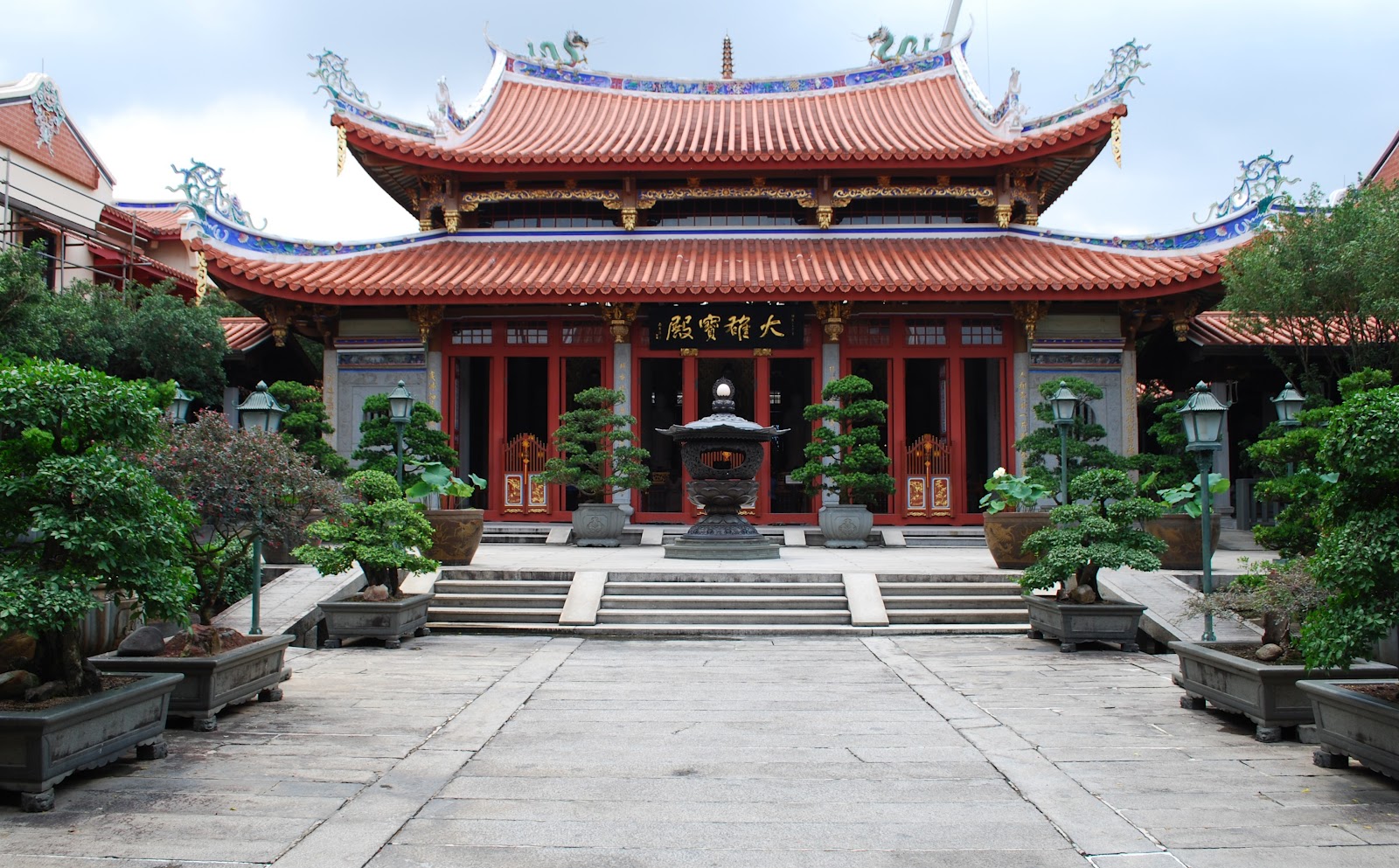
Shuanglin Temple.
Nearby Attractions
In addition to Shuanglin Temple, Pingyao County is home to various historical sites:
- Ancient City of Pingyao: A UNESCO World Heritage site known for its well-preserved Ming and Qing architecture.
- Wang Family Compound: A stunning example of traditional Chinese courtyard architecture, located just a short distance from the temple.
- Zhangbi Ancient Castle: An impressive historical fortification that offers a glimpse into China’s military history.
Final Thoughts
Visiting Shuanglin Temple is more than just a sightseeing trip; it’s an opportunity to immerse yourself in the spiritual and artistic traditions of China. With its breathtaking sculptures and serene ambiance, the temple promises a memorable experience that will resonate long after your visit. Whether you’re a history buff, art lover, or simply seeking a peaceful retreat, Shuanglin Temple should undoubtedly be on your travel itinerary.

Shuanglin Temple.
Tickets: Prices, Booking, and Tips
When planning your visit to Shuanglin Temple, an exquisite gem of Chinese history and culture located just outside Pingyao, it’s important to have all the details regarding tickets, booking, and insider tips to enhance your experience.
Ticket Information
-
Admission Fee: The entrance ticket to Shuanglin Temple typically costs ¥50 (approximately $7 USD). This fee grants you access to the temple grounds and its impressive collection of sculptures and clay figures.
-
Discounts: Discounts may be available for students and seniors, so it’s worth inquiring at the ticket booth if you qualify.
Booking Options
-
On-site Purchase: Tickets can be purchased directly at the temple entrance. This is the most straightforward method, especially for spontaneous visits.
-
Guided Tours: For a richer experience, consider booking a guided tour that includes Shuanglin Temple. Numerous options are available, ranging from half-day to full-day excursions that may encompass other nearby attractions like the Wang Family Compound or the Ancient City of Pingyao. Prices for these tours generally start at ¥142 (about $20 USD) and can go up depending on the inclusions.
Tips for Your Visit
-
Timing: Arrive early in the day to avoid crowds and fully appreciate the serene atmosphere of the temple. Mornings, especially on weekdays, tend to be quieter.
-
Photography Restrictions: Be aware that photography is not permitted inside the main halls, where many of the most impressive sculptures are located. You can take photos in the outdoor areas, so plan accordingly.
-
Transportation: Shuanglin Temple is about a 10-minute drive from the center of Pingyao. Taxis are readily available, or you might consider joining a tour that provides transportation.
-
Dress Code: As with many religious sites in China, it is advisable to dress modestly. Comfortable shoes are recommended, as you’ll be doing some walking on uneven surfaces.
-
Guided Tours: Hiring a local guide can enhance your experience significantly. They can provide valuable insights into the temple’s history and the meanings behind the numerous sculptures, which span various themes such as Buddhas, Devas, and Bodhisattvas.
-
Plan for Dust: Some visitors have noted that the temple can be dusty, so if you’re sensitive to dust, consider bringing a mask or a scarf.
By keeping these details in mind and planning ahead, your visit to Shuanglin Temple will not only be memorable but also a profound journey into the heart of Chinese artistic and spiritual heritage.
How to Get There: A Complete Transportation Guide
Reaching Shuanglin Temple: Your Comprehensive Transportation Guide
Nestled in the picturesque Pingyao County, Shuanglin Temple is a hidden gem that boasts a rich history and stunning architectural beauty. Known for its remarkable collection of nearly 2,000 sculptures and clay figures, this temple is a must-visit for history and culture enthusiasts. Here’s how to get there, ensuring a smooth and enjoyable journey.
Getting to Pingyao
Before you can explore Shuanglin Temple, you’ll need to reach Pingyao, the nearest town. Here are the primary modes of transportation available:
1. By Air:
– Closest Airport: The nearest major airport is Datong Yungang Airport (DAT), located about 100 kilometers from Pingyao.
– Alternative Airport: Taiyuan Airport (TYN) is another option, approximately 120 kilometers away.
– Transportation from the Airport:
– Taxi: Directly hire a taxi or use ride-sharing services. Expect a travel time of around 1.5 to 2 hours.
– Airport Shuttle: Some shuttles might be available, but confirm ahead of time.
2. By Train:
– Train Station: Pingyao has its own train station, making it accessible from various cities.
– From Major Cities:
– Beijing to Pingyao: High-speed trains run frequently, taking around 4-5 hours.
– Xi’an to Pingyao: Expect a travel time of approximately 6-7 hours.
– Arrival at Pingyao Station: Taxis and local buses are available outside the station to take you to Shuanglin Temple.
3. By Bus:
– Long-Distance Buses: Several bus routes connect Pingyao with surrounding cities like Taiyuan and Datong.
– From Taiyuan: Buses depart regularly from the Taiyuan Long-distance Bus Station, with a trip lasting about 2-3 hours.
– Local Transport in Pingyao: Once in Pingyao, you can opt for a taxi or a local bus to reach the temple.
Getting to Shuanglin Temple
Once you’re in Pingyao, Shuanglin Temple is a short drive away. Here are your options:
1. Taxi:
– Travel Time: Approximately 10-15 minutes from central Pingyao.
– Costs: Expect to pay around 20-30 RMB (approx. $3-5 USD), depending on traffic.
2. Private Tours:
– Many travelers prefer to join private tours that include Shuanglin Temple as part of a day trip. This often covers other nearby attractions, providing a comprehensive experience.
– Options: Check local tour operators for packages that fit your schedule and interests.
3. Bicycle Rentals:
– For the adventurous, renting a bicycle can be a delightful way to reach the temple.
– Distance: About 7 kilometers from the Old Town of Pingyao, making for a scenic ride through the countryside.
4. Walking:
– If you’re feeling energetic, you can walk to Shuanglin Temple. The route offers beautiful views, though plan for a leisurely 1.5-hour trek.
Tips for Your Visit
- Plan Ahead: Check the opening hours of Shuanglin Temple before your visit. It’s generally open from 8:00 AM to 5:00 PM.
- Guided Tours: Consider hiring a guide to enhance your experience, as they can provide insights into the temple’s historical and cultural significance.
- Photography Restrictions: Be aware that photography may be limited inside the temple, so plan accordingly.
- Dress Appropriately: As a site of worship, respectful attire is recommended.
With its unique blend of history, culture, and stunning artistry, a visit to Shuanglin Temple is sure to be a highlight of your journey through China. Enjoy your adventure!
Local Cuisine and Accommodation Nearby
When visiting the enchanting Shuanglin Temple, the journey doesn’t have to end with its astounding terracotta sculptures and intricate architecture. The surrounding area of Pingyao County boasts a rich culinary scene and a variety of charming accommodations that can elevate your experience. Here’s a guide to savoring local flavors and finding comfortable lodgings nearby.
Delightful Local Cuisine
1. Noodle Dishes at Pingyao Noodle Shop
A trip to Pingyao wouldn’t be complete without trying its famous handmade noodles. The Pingyao Noodle Shop offers a cozy atmosphere where you can sample doughy, hand-pulled noodles served in fragrant broths, topped with fresh vegetables and tender meats. The beef noodle soup here is a must-try, bursting with flavors that reflect the region’s culinary heritage.
2. Shandong Cuisine at Wang’s Family Compound Restaurant
Just a stone’s throw from Shuanglin Temple, this restaurant serves traditional Shandong cuisine, renowned for its emphasis on fresh ingredients and bold flavors. Be sure to try the sweet and sour carp and braised chicken with mushrooms. The ambiance is warm and inviting, perfect for enjoying a hearty meal after your temple visit.
3. Street Food at Pingyao Old Town
As you wander through the ancient streets of Pingyao, indulge in local street food. From baozi (steamed buns) filled with savory fillings to jiaozi (dumplings), the options are endless. Don’t miss out on the pingyao beef, a savory delicacy that has gained fame beyond the region.
4. Tea Houses
Pingyao is also home to several quaint tea houses where you can sip traditional Chinese tea. Huangjue Tea House is a favorite among locals and tourists alike, offering a range of teas along with light snacks. It’s the perfect spot to relax and reflect on your experiences at the temple.
Comfortable Accommodations
1. Pingyao Yide Hotel
Located conveniently close to both Shuanglin Temple and the heart of Pingyao Ancient City, the Pingyao Yide Hotel offers a blend of modern comforts and traditional architecture. With its beautifully decorated rooms and attentive service, it’s an ideal base for exploring the area.
2. Xie’s Courtyard
For an authentic experience, consider staying at Xie’s Courtyard, a traditional guesthouse that exudes the charm of ancient Pingyao. Enjoy the serene courtyard and comfortable rooms, and engage with friendly staff who can provide insights into local culture and attractions.
3. Pingyao Harmony Hotel
This delightful hotel is known for its friendly atmosphere and is situated just a short drive from Shuanglin Temple. The rooms are well-furnished, and the hotel features a lovely garden area where you can unwind after a busy day of sightseeing.
4. Boutique Guesthouses
For a more intimate experience, several boutique guesthouses scatter the old town of Pingyao, such as Old Pingyao Inn and Pingyao Tujia Guesthouse. These offer unique accommodations with personalized service, perfect for travelers seeking a homely touch during their stay.
Conclusion
Whether you are indulging in the rich flavors of local cuisine or resting in one of the charming accommodations nearby, your experience around Shuanglin Temple will be as memorable as the temple itself. Embrace the culture, savor the food, and enjoy the hospitality that this historic region has to offer.
Frequently Asked Questions
Frequently Asked Questions About Shuanglin Temple
1. What is Shuanglin Temple known for?
Shuanglin Temple is renowned for its impressive collection of nearly 2,000 terracotta sculptures and clay figures, which date from the 12th to the 19th centuries. These artworks are among the finest examples of their kind in China, showcasing intricate craftsmanship and a variety of religious themes.
2. How do I get to Shuanglin Temple from Pingyao?
Shuanglin Temple is conveniently located about 7 kilometers (approximately 4.3 miles) from the ancient city of Pingyao. You can reach the temple by hiring a taxi, joining a guided tour, or renting a bicycle for a more leisurely approach.
3. Are there any entrance fees?
Yes, there is an entrance fee to visit Shuanglin Temple. The exact amount may vary, so it’s advisable to check the latest information before your visit. Ticket prices typically include access to the main halls and the surrounding grounds.
4. Is photography allowed inside the temple?
Photography is generally restricted inside the main buildings of Shuanglin Temple, particularly where the most significant sculptures are located. Visitors are encouraged to respect these rules to preserve the sanctity of the site.
5. What are the best times to visit the temple?
To avoid crowds and enjoy a more peaceful experience, it is recommended to visit early in the morning or later in the afternoon. Weekdays are typically less busy than weekends. Spring and autumn are ideal seasons for comfortable weather.
6. Can I hire a guide at the temple?
While there may be guides available on-site, it’s advisable to book a local guide in advance, especially if you wish to gain deeper insights into the temple’s rich history and the significance of its sculptures. Many guided tours from Pingyao include Shuanglin Temple in their itineraries.
7. What can I expect to see during my visit?
At Shuanglin Temple, visitors can explore various themed halls, each dedicated to different aspects of Buddhism, such as the Thousand Buddhas, Bodhisattvas, and Arhats. The intricate wood carvings and architectural details are also noteworthy, making the temple a treasure trove of art and culture.
8. Are there any amenities available for visitors?
Basic amenities such as restrooms and a small gift shop may be available at or near the temple. However, food options are limited, so it’s a good idea to bring water and snacks if you plan on spending a considerable amount of time exploring the temple grounds.
Final Thoughts on Your Trip
As you conclude your journey through the captivating realm of Shuanglin Temple, let the echoes of its rich history and artistry resonate within you. Nestled just a short drive from the ancient town of Pingyao, this incredible site is often overlooked, yet it stands as a testament to the enduring beauty of Chinese culture and religious devotion.
A Hidden Gem
Shuanglin Temple is more than just a collection of structures; it is a treasure trove of nearly 2,000 sculptures and clay figures that span centuries. From the intricate wooden carvings to the stunning terracotta figures, each corner of the temple tells a story of profound spiritual significance. As you wander through its hallowed halls, you will find yourself immersed in a world where art and history intertwine seamlessly.
Experience the Serenity
Despite its historical importance, Shuanglin Temple often sees fewer tourists than its counterparts, offering you a unique chance to explore in peace. This tranquil environment allows for reflection and appreciation, making it an ideal spot to meditate on your travels and the cultural wealth of China. Ensure to take your time here; absorb the calming atmosphere and let the artistry wash over you.
Practical Tips for Your Visit
- Guided Tours: Consider hiring a knowledgeable guide to help you navigate the rich symbolism and intricate details of the temple’s various halls, including the themes of Thousand Buddhas, Devas, and Bodhisattvas.
- Photography Restrictions: Be mindful of the photography rules, as many of the most striking sculptures are located in areas where cameras are not permitted.
- Preservation: While the temple may show signs of wear, its charm lies in its authenticity. Each dusty statue carries the weight of history, urging you to appreciate its story rather than its pristine condition.
A Journey Worth Taking
In a world teeming with bustling tourist hotspots, Shuanglin Temple offers a refreshing escape into the serene and spiritual. This remarkable site beckons you to delve deeper into the tapestry of Chinese heritage. As you leave, carry with you not just memories of stunning artistry and historical significance, but also a renewed appreciation for the intricate narratives that shape our world. Embrace the adventure and allow your visit to Shuanglin Temple to be a pivotal chapter in your exploration of China’s rich cultural landscape.